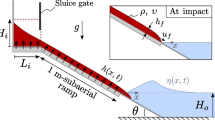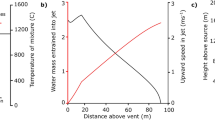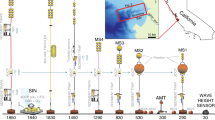Abstract.
The entrance of hot pyroclastic flows into water has been observed in a series of experiments in which shooting granular flows of hot ignimbrite ash (≤403 °C), of bulk density near that of water, run down a smooth chute and enter a water-filled tank at an angle of 26°. Flows of relatively cool ash (<150 °C) impulsively displace some volume of near-shore water upon impact, generating a water wave that rapidly travels away from shore. The granular flow material then separates into two portions. (1) A fine-ash surge cloud is formed where the granular flow hits water and rapidly travels down-tank over the water. (2) The main portion of material penetrates the surface and mixes with the water, creating a turbulent mixing zone resembling a hydraulic jump, which advances downstream as long as the pyroclastic flow is maintained. Most pumice floats to the surface, lithics and coarse ash fall out onto the floor, but ash that remains in suspension forms a turbidity current that travels down the floor of the tank. With increasing ash temperature, an increasing fraction of incoming material is initially transported along the water surface; almost all material takes this path at temperatures >250 °C. Mixing across the water surface over some distance from shore generates steam explosions forming fountains of wet and dry ash and convectively rising fine-ash plumes. Steam explosions increase in strength and lateral extent towards higher ash temperatures and mass fluxes. The explosions generate water waves that remain driven by massive fountain fallout across some distance from shore. The ash fountains feed pyroclastic surges, which advance down tank over water at high speeds. Underwater plumes of sediment falling from the ash fountains and surges drop coarse load onto the floor whereas the finer load forms a turbidity current. High temperature and poor size sorting of pyroclastic flows are key parameters that determine the processes of interaction with water and the associated hazards. Poor sorting allows for the formation of ash-cloud surges moving over water, even from cool flows. High temperatures cause littoral explosions and facilitate extensive mass transport over water. All flows generate tsunami waves by different mechanisms.
Electronic supplementary material (two movies) is available if you access this article at http://dx.doi.org/10.1007/s00445-002-0250-1. On that page (frame on the left side), a link takes you directly to the supplementary material.
Similar content being viewed by others
Author information
Authors and Affiliations
Additional information
Electronic Publication
Electronic supplementary material
Electronic supplementary material (coolrun14.mov)
Electronic supplementary material (hotrun15.mov)
Rights and permissions
About this article
Cite this article
Freundt, A. Entrance of hot pyroclastic flows into the sea: experimental observations. Bull Volcanol 65, 144–164 (2003). https://doi.org/10.1007/s00445-002-0250-1
Received:
Accepted:
Published:
Issue Date:
DOI: https://doi.org/10.1007/s00445-002-0250-1




